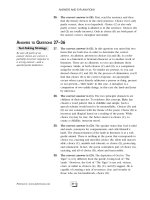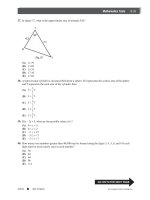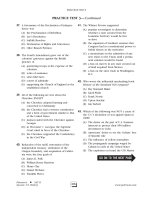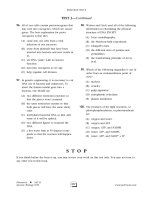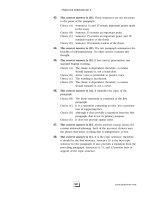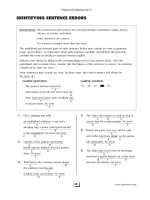New SAT Writing Workbook Episode 2 Part 8 pps
Bạn đang xem bản rút gọn của tài liệu. Xem và tải ngay bản đầy đủ của tài liệu tại đây (157.57 KB, 9 trang )
27. The correct answer is (C). The sentence does not have a
misplaced modifier nor is it wordy.
Choice (A) This choice is very wordy and has a misplaced
modifier.
Choice (B) The modifiers are misplaced, leaving the meaning
ambiguous.
Choice (D) The sentence is wordy, and the placement of
modifiers is awkward.
Choice (E) The use of passive voice is not desirable.
28. The correct answer is (B). The superlative most is correct.
Choice (A) The comparative more is incorrect.
Choice (C) The comparative more is incorrect.
Choice (D) The modifiers are misplaced.
Choice (E) There are more than two items being compared, so
better is incorrect.
29. The correct answer is (D). The subject of the sentence is the
singular no one, so the verb must be singular, knows.
Choice (A) The subject no one is singular; therefore, the verb
must be the singular knows.
Choice (B) The objective pronoun me should be used. Don’t
be confused by the placement of me. It is part of
the compound object of the preposition but. But
can be used in place of the preposition except as it
is being used here.
Choice (C) The objective pronoun me should be used.
Choice (E) The tense of the verb is incorrect.
30. The correct answer is (C). The use of the phrase but also
gives the sentence parallel construction.
Choice (A) The conjunction not only needs to be paired with
but also.
Choice (B) The pronoun their is incorrect.
Choice (D) The pronoun they is incorrect.
Choice (E) The verb can is not necessary to convey the
meaning of the sentence.
31. The correct answer is (D). The verb construction is parallel in
all three parts.
Choice (A) The wording lacks parallel construction.
Choice (B) The pronoun it is incorrect.
Choice (C) Commas are needed to separate items in a series.
Choice (E) The verb selection improperly changes the meaning
of the sentence.
PART III: PUTTING IT ALL TOGETHER
366
www.petersons.com
32. The correct answer is (A). The wording is direct and to the
point.
Choice (B) The wording is redundant.
Choice (C) A comma is required to set off the introductory
phrase.
Choice (D) The wording is redundant.
Choice (E) The wording is awkward.
33. The correct answer is (C). The wording is simple and to the
point.
Choice (A) The modifier world’s center is misplaced.
Choice (B) The tense of the verb is incorrect.
Choice (D) The modifier world’s center is misplaced.
Choice (E) The wording is awkward.
34. The correct answer is (A). The punctuation and wording are
correct.
Choice (B) A semicolon, not a comma, is needed to separate
two independent clauses.
Choice (C) The placement of the modifier especially those of
an earlier day is not clear and direct.
Choice (D) Commas are required to set off parenthetical
comments.
Choice (E) A comma is required before the conjunction and.
35. The correct answer is (E). The sentence is direct and has
parallel construction.
Choice (A) The verb completing is not parallel with was
pleased.
Choice (B) A comma is required after car.
Choice (C) The tense of the verb is incorrect.
Choice (D) The wording is awkward.
36. The correct answer is (B). The plural were is properly used
here because the subject is compound.
Choice (A) The verb was should be replaced by the plural
were in both locations.
Choice (C) The verb was should be replaced by the plural
were.
Choice (D) The verb was should be replaced by the plural
were.
Choice (E) The inclusion of one is superfluous.
PRACTICE EXERCISE SET 4
367
www.petersons.com
37. The correct answer is (D). This choice eliminates the im-
proper use of his and avoids redundancy.
Choice (A) The possessive pronoun his cannot refer to the
possessive proper noun Johnson’s.
Choice (B) The verb tense is incorrect.
Choice (C) The possessive pronoun his cannot refer to the
possessive proper noun Johnson’s.
Choice (E) The wording contains a redundancy.
38. The correct answer is (C). The unnecessary by me is re-
moved, and the punctuation is correct.
Choice (A) The phrase by me is redundant.
Choice (B) The proper idiom is at every turn.
Choice (D) The tense of the verb was arguing is incorrect.
Choice (E) The conjunction and is unnecessary.
IMPROVING PARAGRAPHS
39. The correct answer is (C). The punctuation and voice are
correct.
Choice (A) A semicolon is needed to separate two independent
clauses.
Choice (B) It is preferable to use the active voice.
Choice (D) The conjunction and alters the meaning of the
selection.
Choice (E) The tense of the verb is incorrect.
40. The correct answer is (A). This choice is succinct and avoids
improper diction.
Choice (B) This choice is unnecessarily wordy.
Choice (C) The phrase despite the concerns of many is
misplaced.
Choice (D) The word unmatchable is improper diction. The
proper word is unmatched.
Choice (E) This choice is unnecessarily wordy.
41. The correct answer is (D). This choice is direct and to the
point. The shortest answer is often the best. It must still convey
the writer’s thought, but the brief answer will avoid errors that
are contained in the longer choices.
Choice (A) The second clause is not independent; therefore,
the semicolon is incorrect.
Choice (B) The past tense wasn’t is incorrect.
Choice (C) The wording is a sentence fragment.
Choice (E) The active voice is preferable to the passive voice.
PART III: PUTTING IT ALL TOGETHER
368
www.petersons.com
42. The correct answer is (B). The pronoun their is correct, and
the wording is direct.
Choice (A) The possessive pronoun one’s is incorrect.
Choice (C) The possessive pronoun one’s is incorrect.
Choice (D) The phrase in statistics incorrectly modifies
argument.
Choice (E) The phrase to that effect is unnecessary.
43. The correct answer is (A). All elements of the sentence are
correct.
Choice (B) In context, the noun people, not flying, should be
the subject of the sentence.
Choice (C) The tense of the verb have remained is incorrect.
Choice (D) Don’t be confused by the use of some to refer to
people. The relative pronoun who is still correct, so
that is incorrect.
Choice (E) The change in the verb to might alters the tone of
the sentence.
44. The correct answer is (E). This choice contains a good
statement of theme, transition, and summary.
Choice (A) The choice is too firm in its assessment of the
nonfliers’ liking flying.
Choice (B) The choice is too firm in its assessment of the
nonfliers’ enjoying flying.
Choice (C) The choice incorrectly shifts to second person.
Choice (D) The phrase having looked at all of the available
data is a misplaced participle.
45. The correct answer is (B). The sentence corrects the error in
subject-verb agreement.
Choice (A) The choice contains singular verbs that do not
agree with the plural subject problems and annoy-
ances.
Choice (C) The choice corrects the agreement error, but the
sentence begins with a conjunction but.
Choice (D) The choice does not correct the subject-verb
problem.
Choice (E) The sentence is missing a comma after the transi-
tion however and does not correct the subject-verb
error.
PRACTICE EXERCISE SET 4
369
www.petersons.com
46. The correct answer is (A). The sentence is in the preferred
active voice.
Choice (B) The choice contains two awkwardly worded
clauses written in the passive voice.
Choice (C) The sentence is overwritten.
Choice (D) Besides the use of the passive voice, this sentence
includes a pronoun-agreement error.
Choice (E) This passive sentence changes the meaning of the
original.
47. The correct answer is (C). The choice is succinct and adds
sentence variety to the essay.
Choice (A) This choice makes equal two clauses of unequal
weight. Being the unmowed area and being able to
pose problems are not equal qualities, but in this
choice, being joined by and makes them seem
equal.
Choice (B) The choice is illogical.
Choice (D) The choice contains a comma splice.
Choice (E) The sentence is incomplete.
48. The correct answer is (B). The sentence contains a necessary
transition. See page 37 for a chart showing transitions for
different types of writing organization.
Choice (A) The choice does not have a transition.
Choice (C) The sentence requires a comma to separate the two
independent clauses.
Choice (D) While the sentence does have a transition, next is
used for chronological or spatial development.
Choice (E) The choice uses the semicolon incorrectly. A
comma would be correct.
49. The correct answer is (E). The use of transitional words
makes the essay’s development by order of importance easy to
follow.
Choice (A) The paragraph requires transition, but this choice
has none.
Choice (B) This choice is wordy.
Choice (C) Nevertheless is an inappropriate transition for
order-of-importance development.
Choice (D) The sentence contains nonstandard English—the
slang word totally.
PART III: PUTTING IT ALL TOGETHER
370
www.petersons.com
50. The correct answer is (A). The sentence repeats the idea
expressed in sentence 6, the thesis statement.
Choice (B) Sentence 25 begins an interesting final comment.
Choice (C) Sentence 26 continues the final comment.
Choice (D) Sentence 27, along with the final sentence, is the
clincher.
Choice (E) Sentence 28 completes the clincher.
PRACTICE EXERCISE SET 4
371
www.petersons.com
QUICK REFERENCE GUIDE
PACING GUIDE FOR WRITING THE ESSAY
5 minutes
Step 1 Read the question carefully.
Step 2 Restate to yourself what the question is asking. Underline the key words.
Step 3 Make a list by brainstorming all the ideas that come to mind. Write down
your ideas.
Step 4 Create a thesis from the ideas you have brainstormed.
Step 5 Turn your brainstorm into an informal working plan by numbering the
items that you want include in your essay in the order in which you want
to include them. Cross out ideas that no longer fit now that you have a
thesis statement.
4 minutes
Step 6 Begin writing your introduction by stating your thesis clearly.
Step 7 Read your first paragraph to be sure that your ideas follow each other
logically and support your thesis.
10 minutes
Step 8 Check your quick list of ideas. Choose the next idea and write a transition
into your second paragraph. Keep writing until you use all the
RELEVANT ideas on your quick list.
4 minutes
Step 9 Write a solid conclusion using one of the following techniques:
(a) rephrasing your thesis, (b) summarizing your main points, (c) referring
in some way back to your introductory paragraph.
2 minutes Step 10 Proofread and revise neatly.
TOP 10 RULES OF EFFECTIVE WRITING
Rule 1: Use Action Verbs and the Active Voice
Rule 2: Use Precise Words
Rule 3: Say What You Mean
Rule 4: Maintain Your Tone
Rule 5: Use Direct Language
Rule 6: Use Concise Language
Rule 7: Improve Sentences
Rule 8: Develop Sentence Variety
Rule 9: Use Standard Rules of English for Capitalization
Rule 10: Use Standard Rules of English for Punctuation
372
STRATEGIES FOR ANSWERING MULTIPLE-CHOICE
QUESTIONS
• Carefully read the entire sentence, NOT just the underlined
phrases. The underlined words may seem correct unless you read
the whole statement.
• As you read, listen for any words or phrases that do not “sound”
right to you. Anything that sounds awkward or strange may be a
mistake.
• Always substitute into the sentence the choices for the part that
you think is incorrect.
• Do not spend time to read choice (A), because it repeats the
original sentence.
• Find the best answer, not one that is simply correct. More than one
choice may be correct, but only one best fits the context.
• If the sentence sounds correct to your ear, the correct choice is
probably (A).
• Answer the easy questions first.
NOTE: Be sure to skip the answer ovals for the questions you skip.
• Look for errors according to difficulty:
1. Capitalization and punctuation errors
2. Grammar and syntax errors
3. Usage, sequence of tenses, parallel structure, redundancy, and
then other errors
• Read a sentence or passage through twice before making any
decision about an answer.
• Identify the subject and the predicate of each sentence to help you
find errors in usage, redundancy, and relevance.
QUICK REFERENCE GUIDE
373
www.petersons.com

